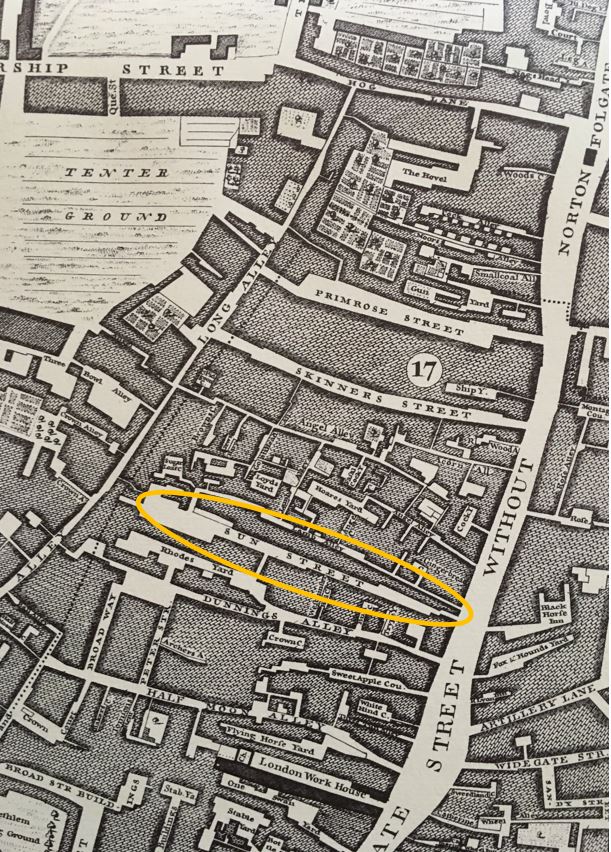I think I first used Liverpool Street Station around 1974, and from 1979 to 1989 I used the station every working day. It is one of my regrets that in all those years I did not take a single photo of the station. Too busy with work and other commitments, the station was also a very familiar sight that I used every day, so why take a photo?
This was a time of slam door trains, carriages with individual compartments, which had a single bench seat along either side of the carriage. Always difficult when you got into one of these compartments which appeared full, but could you squeeze into a gap, and would people shuffle up? Reading your neighbour’s newspaper as they opened it up in front of you.
This is probably why I over compensate now, and take photos of almost everything. The present becomes the past very quickly.
Fortunately my father did take a couple of photos of Liverpool Street Station in 1952. Not the main buildings of the station, but from the far end of the platforms, looking back into the station:
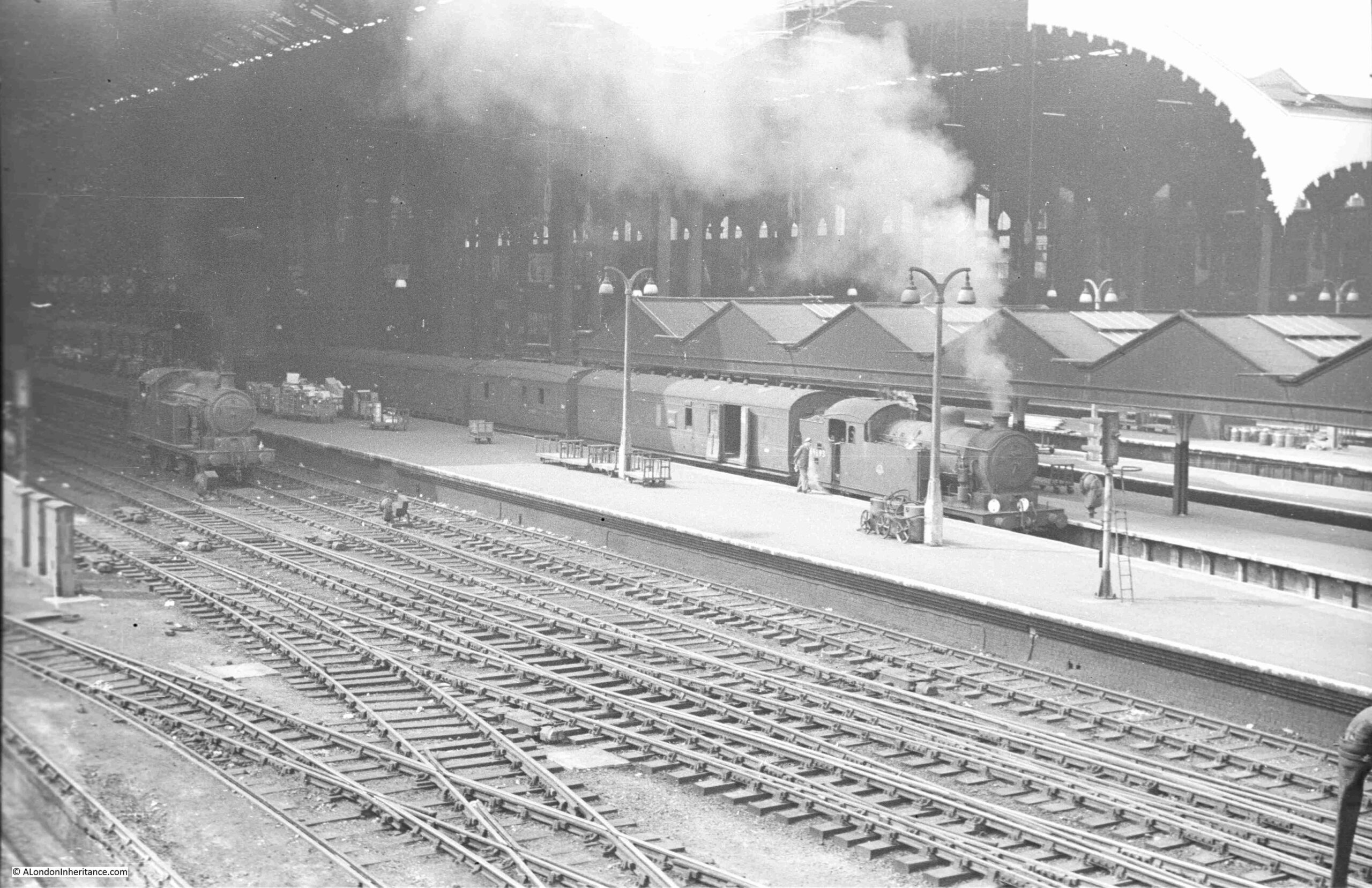
The photo was taken from a rather good viewing point if you wanted to watch trains arriving at, and leaving the station.
The platforms at Liverpool Street Station are slightly below ground level. Not that much, but enough to mean that the tracks left the station in a rather wide cutting with brick retaining walls on either side, and the tracks passing under what were streets, which had been converted to a bridge structure when the tracks were built.
The following map extract is from the 1951 revision of the OS map, so about the same time as my father’s photos. There are two streets crossing the tracks as they leave the station, Pindar Street and Primrose Street.
Pindar Street is closet to the station, and I have marked the location where I believe my father was standing with a red circle (‘Reproduced with the permission of the National Library of Scotland“).
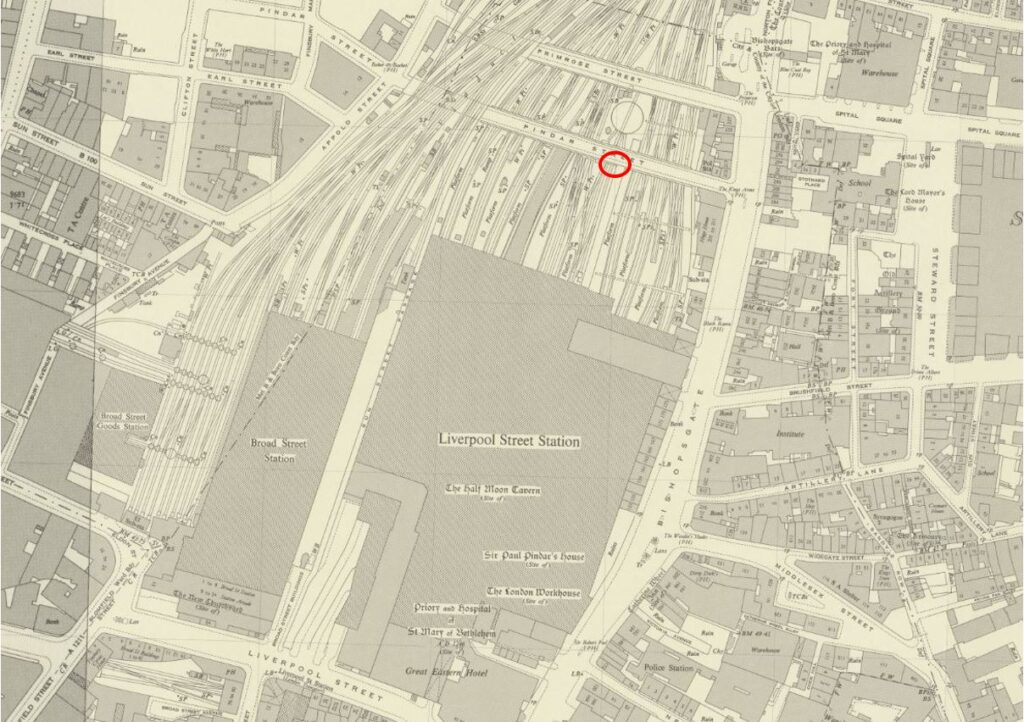
What really helped to confirm the location was finding the following photo of the area on the Britain from Above web site:
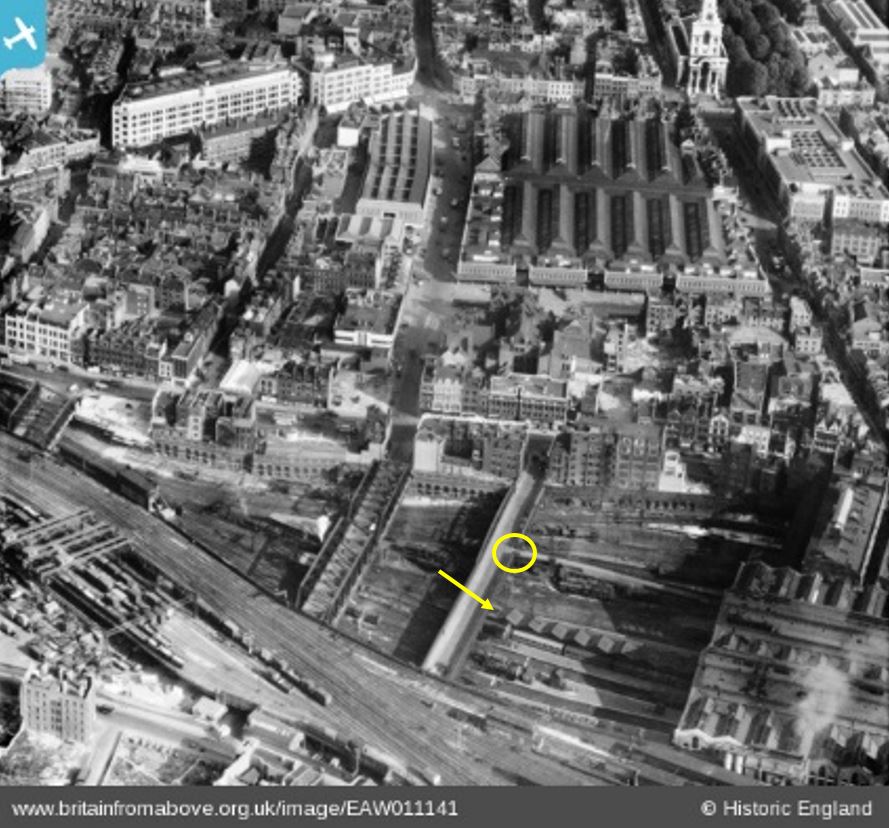
The photo is dated 1947 and shows Liverpool Street Station in the lower right corner, and Pindar and Primrose Streets crossing the tracks leaving Liverpool Street.
The above photo also shows the different approach between Liverpool and Broad Street Stations. Broad Street was next to Liverpool Street, and in the above photo the tracks into Broad Street pass over the streets, where the tracks into Liverpool Street pass under.
The two station platform levels were at different heights. I did take a couple of photos of Broad Street Station in 1986, before it was demolished (see my post on Broad Street Station here). It can be seen on the photos that the station buildings and platforms were higher than those of Liverpool Street.
I have marked the location where my father was standing with a yellow circle in the above photo.
The photo shows that there is a road / ramp leading down from Pindar Street to the station, which would have provided an unobstructed view, also I have marked with a yellow arrow a series of sheds where the roofs form a distinctive pattern. These sheds can be seen in my father’s photo.
I cannot find the exact location from where the following photo was taken, it may have been turning to the left from the above photo, or further along Pindar Street:

I wanted to try and get a photo from the same position today, and although the area around Liverpool Street Station has changed beyond all recognition, I was able to get to a similar position.
The following photo from the top of the Heron Tower / 110 Bishopsgate helps put the location of the station in context.
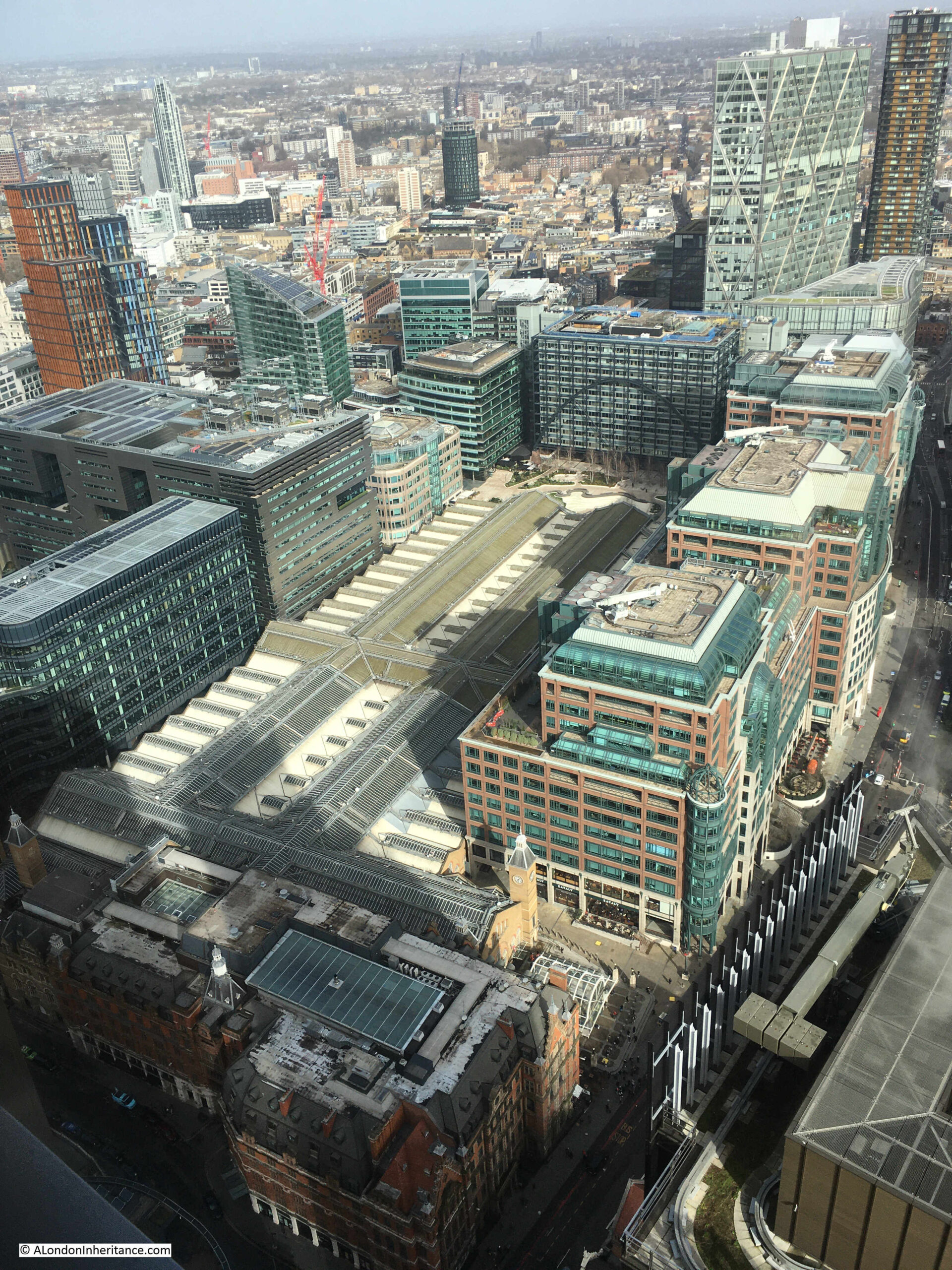
The main buildings of the station can be seen in the lower left corner, with the roof over the main concourse at ninety degrees to the roof over the platform which runs up towards the right.
To the left of the station is the Broadgate development which was constructed on the site of Broad Street Station. On the right of the station, large office blocks have been built between the station roof and Bishopsgate. Some of the Liverpool Street platforms extend under these new office blocks.
The roof of the station appears relatively low compared to the surrounding buildings and ground level, again showing that the platforms of the station are below ground level.
In the above photo, and the photo below, at the upper end of the station roof, there is an office block which has an arch running across the façade, and there is an open space between the office block and the end of the station roof.

The open space is Exchange Square which has recently reopened after a redevelopment, and it is from here that I can get a similar photo to my father’s:
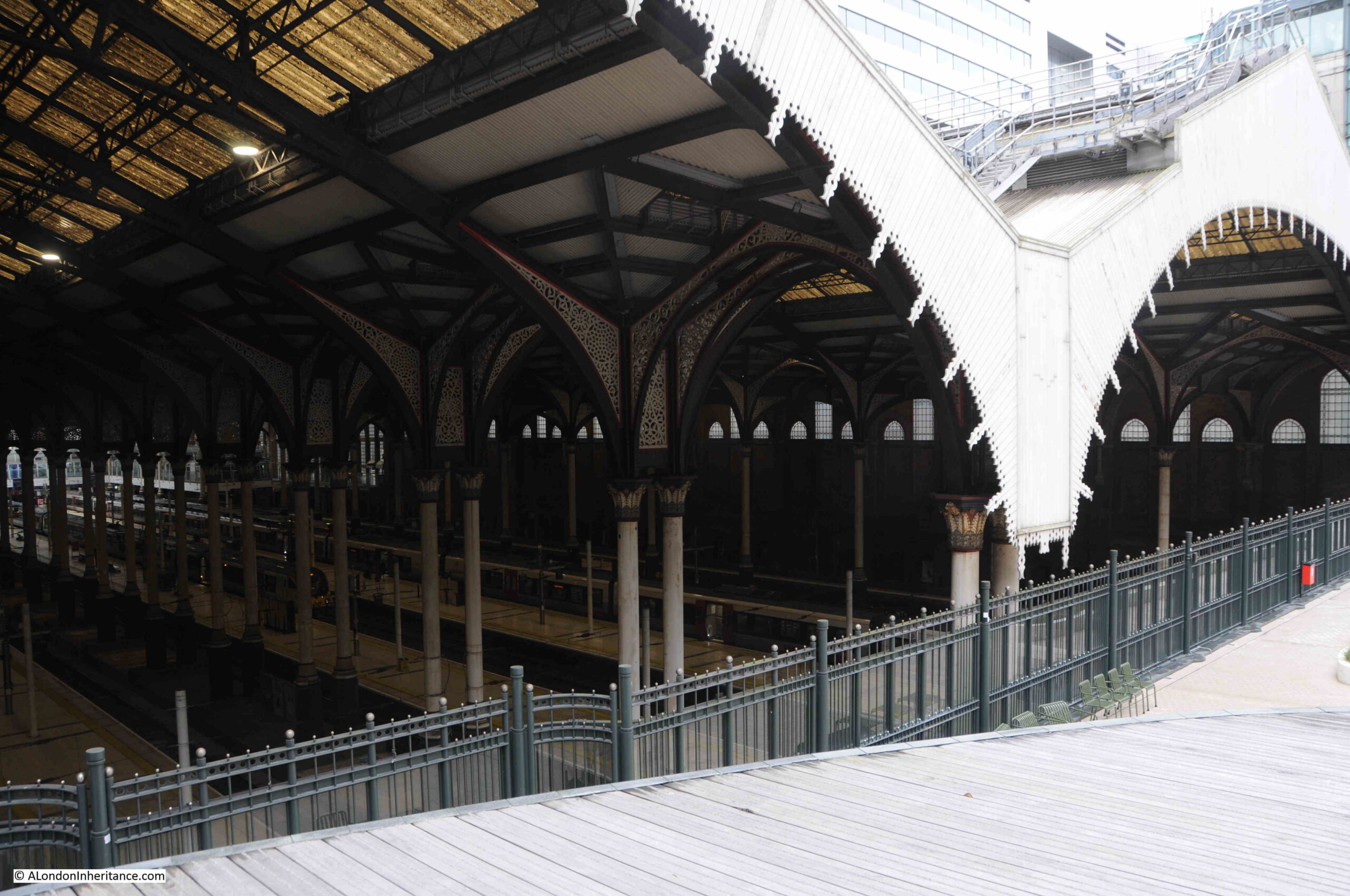
The photo is far closer to the end of the roof over the station platforms than my father’s, and I will explain why shortly. To help confirm that my father’s photo is of Liverpool Street Station, the pattern around the edge of the wooden roof is the same, as are the windows in the brick walls on the far side of both photos.
Exchange Square is a remarkable open space. As can be seen from the above photo, the edge of the space is up against the roof over the station, and from here you can look down directly into the station:
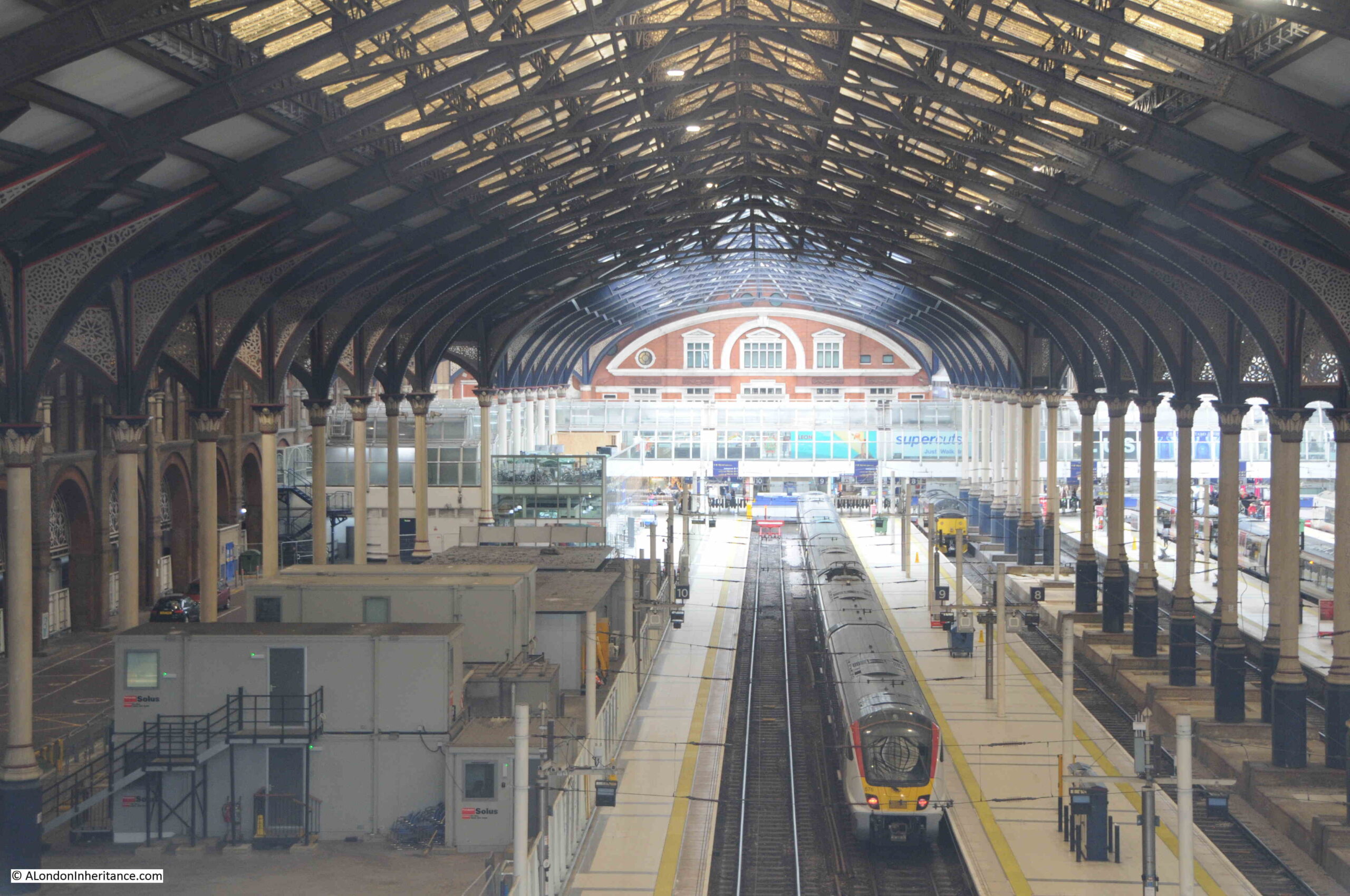
The roof almost comes down to the point where you can stand on the chairs and touch the wooden decoration (you cannot, it is just too high, and the wandering security man would not be very happy if you tried).
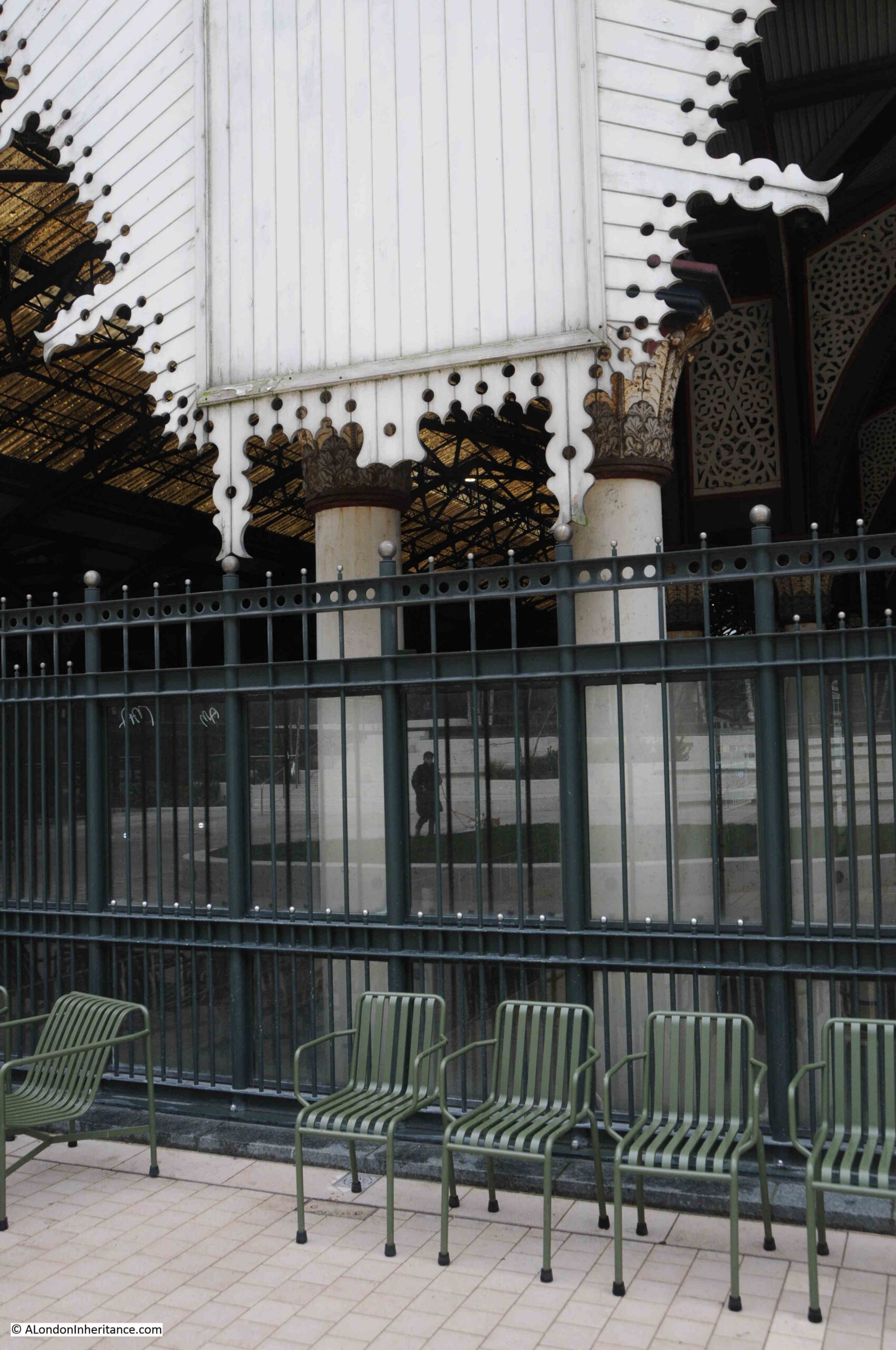
You can get a good view of the decoration at the top of the columns supporting the roof:
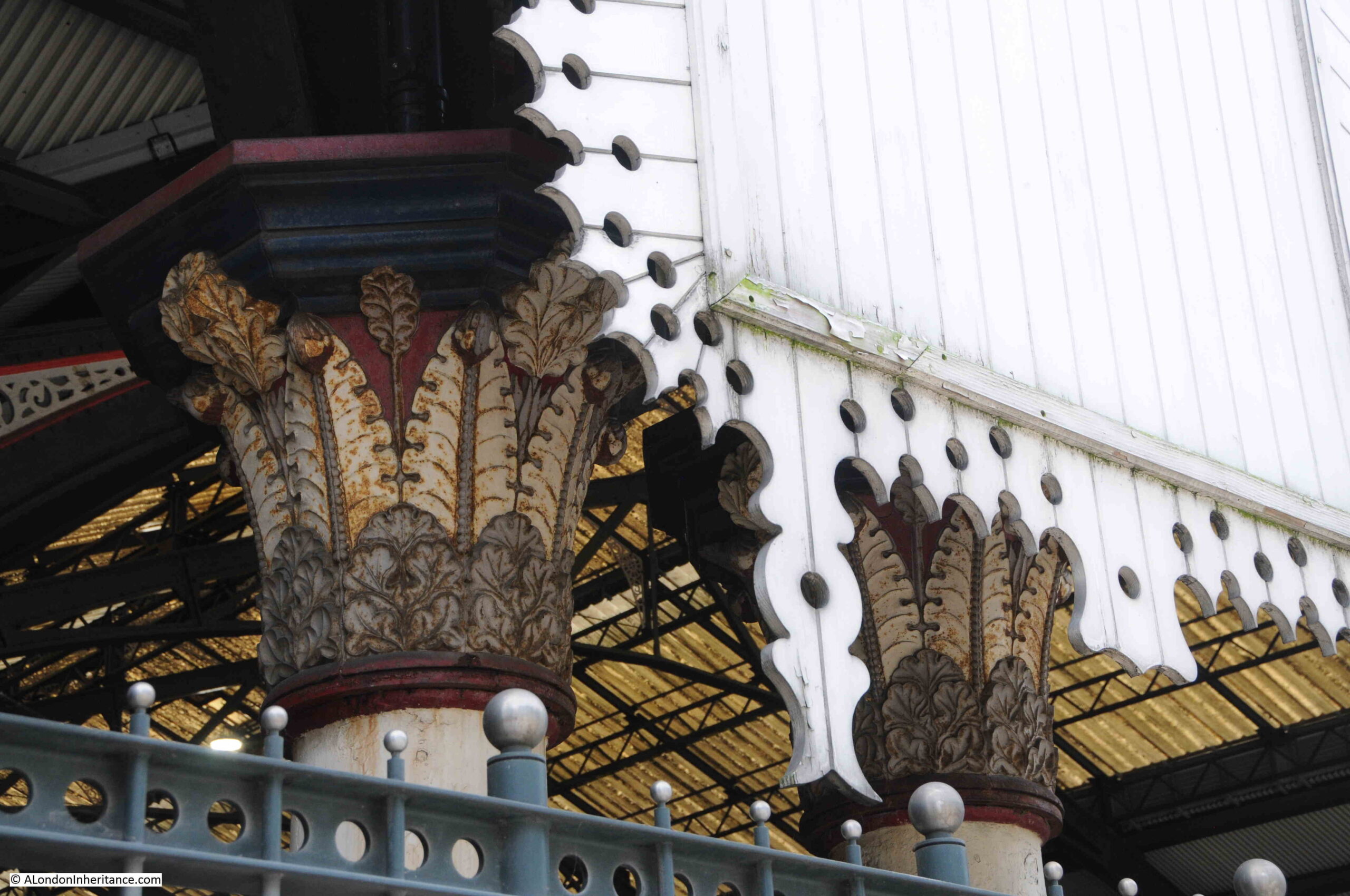
Details of the roof:
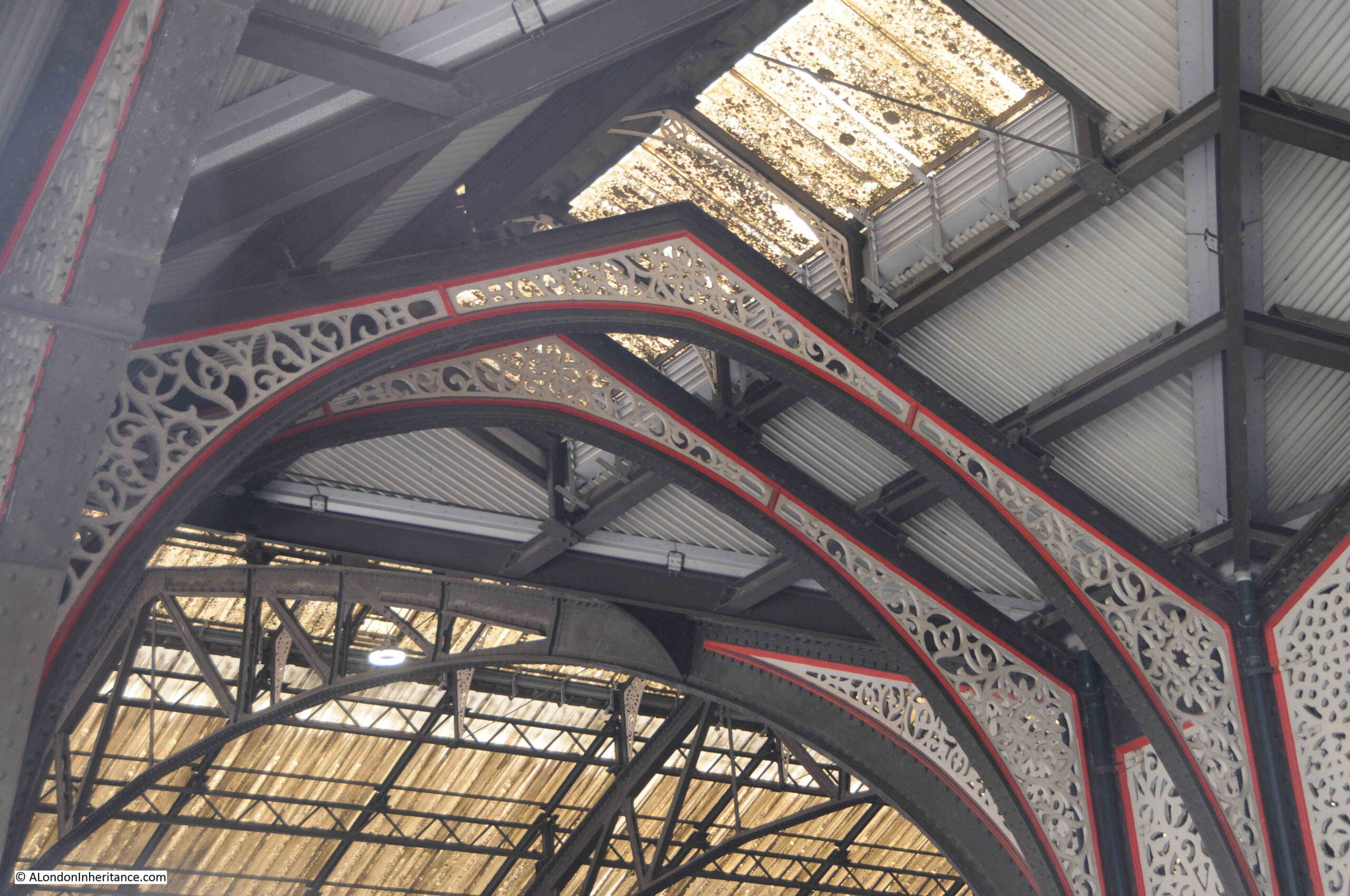
And the roof stretching over the platforms:

The view from Heron Tower shows that the roof over the concourse and part of the platforms closest to the concourse appear to be cleaned, whilst the roof over the main part of the platforms is dirty as shown in the above photo.
I assume this is to save money by only cleaning the roof over the area where people wait for their train, however it is probably my 1970s first experiences of London, but I like the dirty roof – a city can be too clean.
View from the corner of Exchange Square, with the roof of Liverpool Street Station with the two central arches, and smaller flat roof / arches at the sides, with the towers of the City in the background.
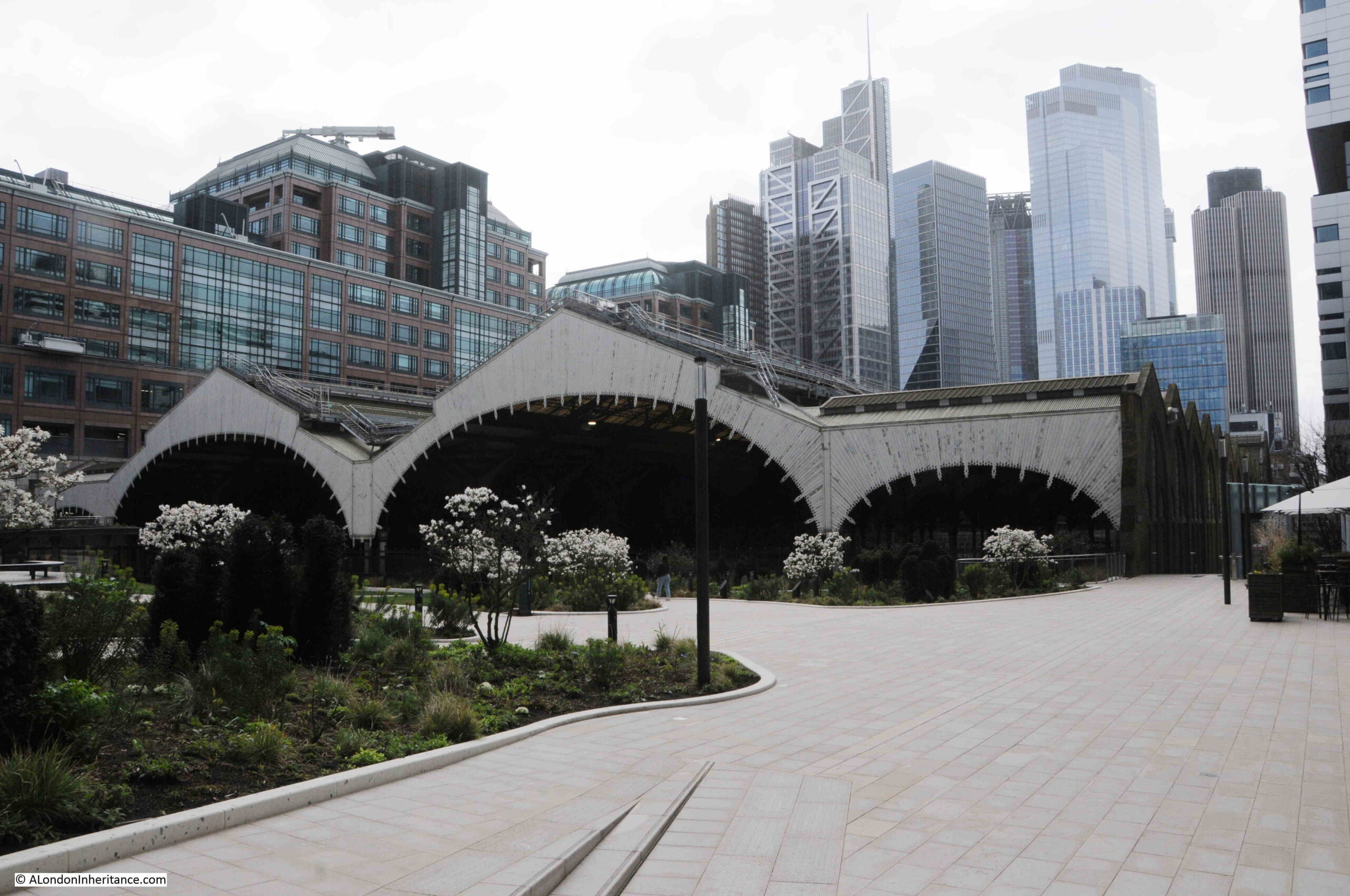
Although Exchange Square has recently reopened, it has long been part of the original Broadgate development, which included a number of works of art, two of which can be seen in Exchange Square.
This is the Broadgate Venus – a 5 tonne patinated bronze, created for Broadgate in 1989 by the Columbia artist and sculptor Fernando Botero:
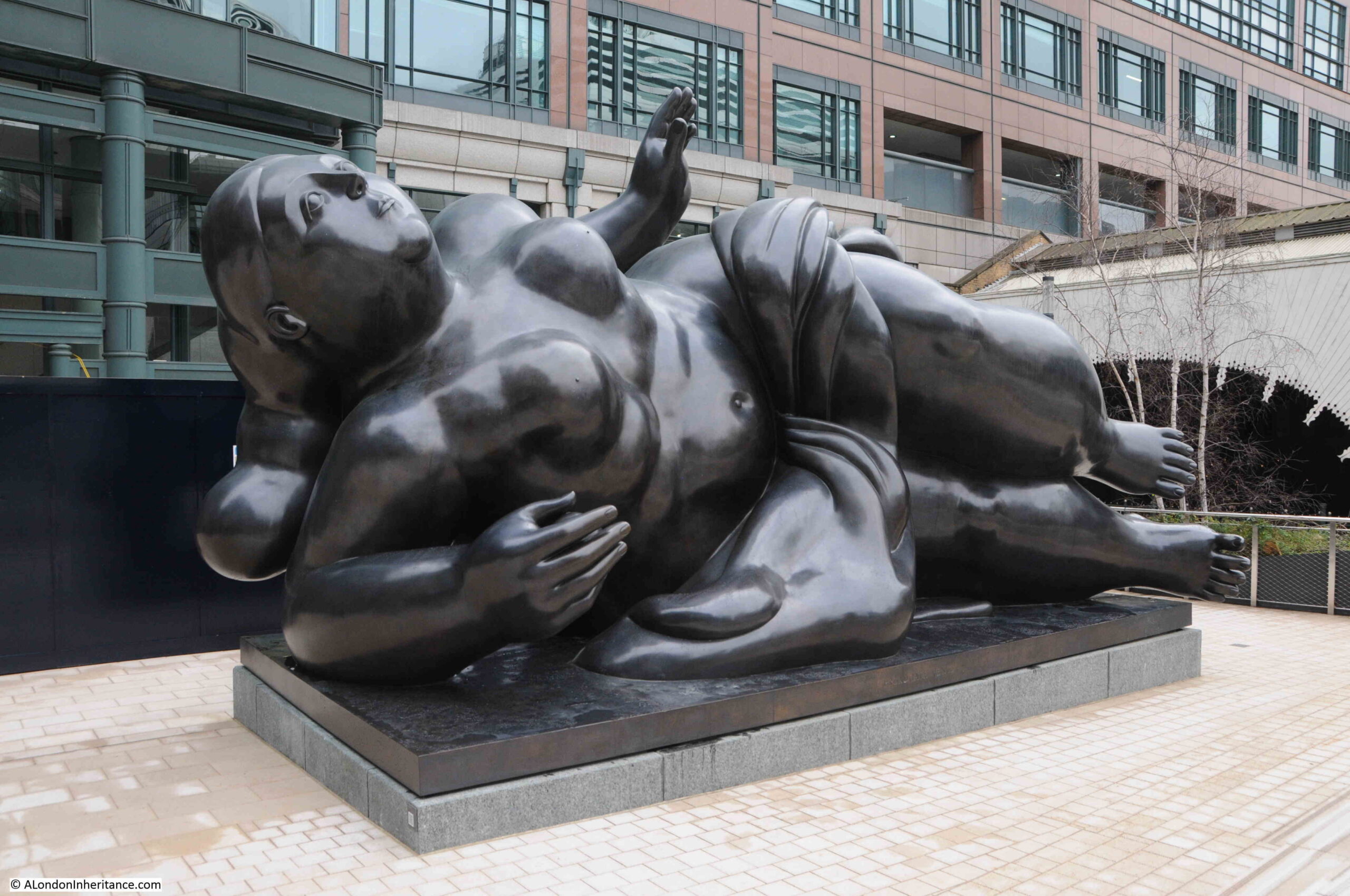
Towards the back of Exchange Square is this group of figures, who look as if they have been wrapped up against the cold of a March day:

The group is a work titled “Rush Hour” by the American artist George Segal and was created in 1982. The work has only recently returned to Broadgate after being stored off site during Exchange Square’s renovation. Hopefully the weather will have warmed up by the time they are unwrapped.
But what of the two streets carried by bridges over the tracks into Liverpool Street Station?
Firstly these are old streets. I have highlighted Primrose Street (yellow oval) and Pindar Street (which was originally Skinners Street – red oval) in the following extract from Rocque’s 1746 map of London:
The map shows the dense network of streets, yards, courts and alleys that were lost when Liverpool Street Station was built.
Primrose and Pindar Street’s remained, but were turned into bridges that ran over the railway, rather than a street with buildings alongside.
Pindar Street disappeared with the building of Broadgate, however Primrose Street does remain, linking Bishopsgate and Appold Street. The following view is looking west along Primrose Street:

It does not look as if you are standing over a large number of rail tracks as there are office blocks on either side of the street, however a couple of things show the true nature of the street.
On the left of the above photo, an expansion gap can be seen running the length of the street, between the paving slabs. This shows that the road is still carried over on a bridge like structure, which can expand at a different rate to the slabs carrying the office blocks on either side.
Also in the above photo, and the following photo which is looking towards Bishopsgate, the road dips at the far end of Primrose Street, rising to the canter as it passes over the tracks.
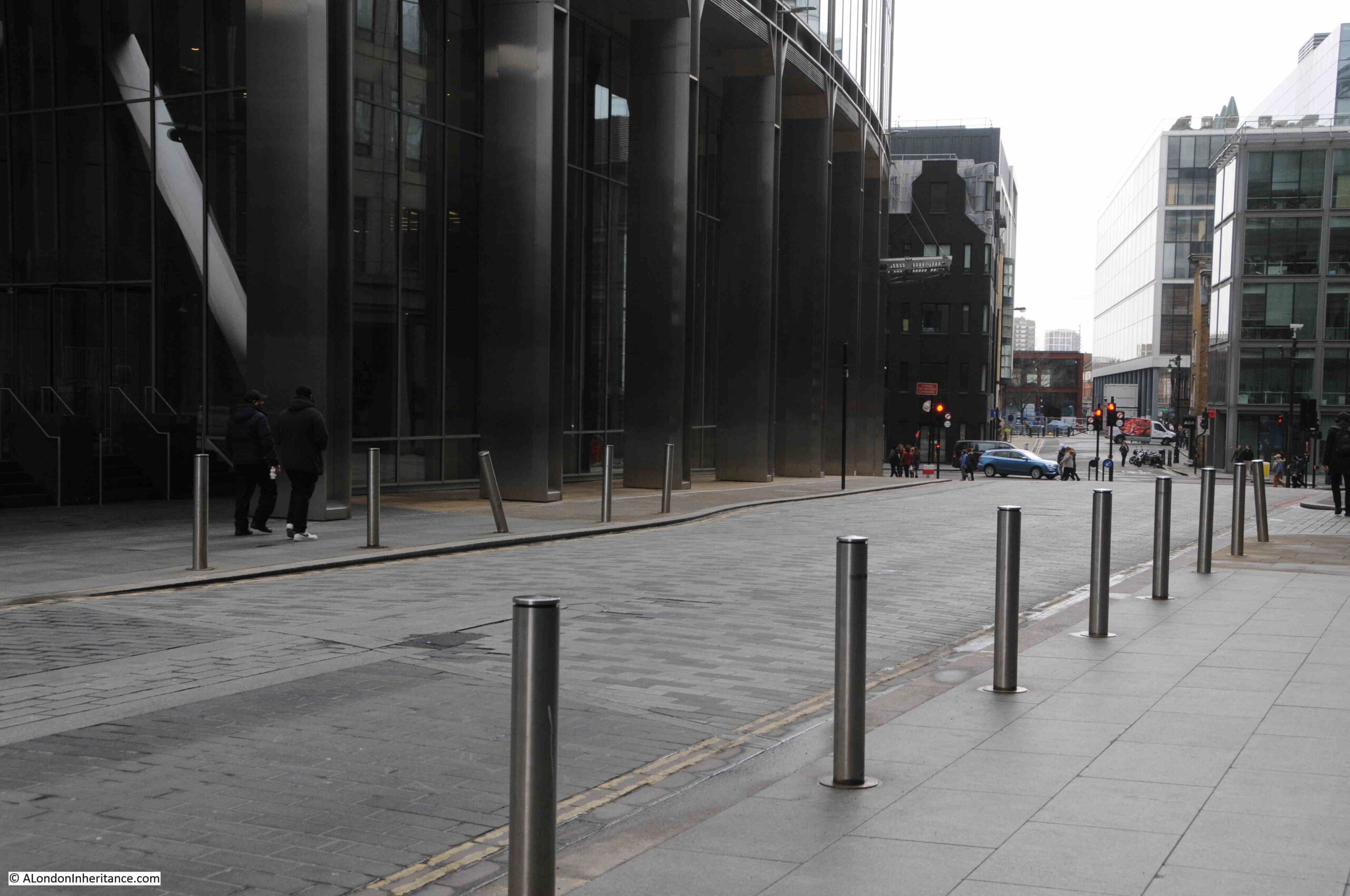
The following photo is looking from Primrose in towards Exchange Square, with part of the roof of Liverpool Street Station just visible. Exchange House is between Exchange Square and Primrose Street:
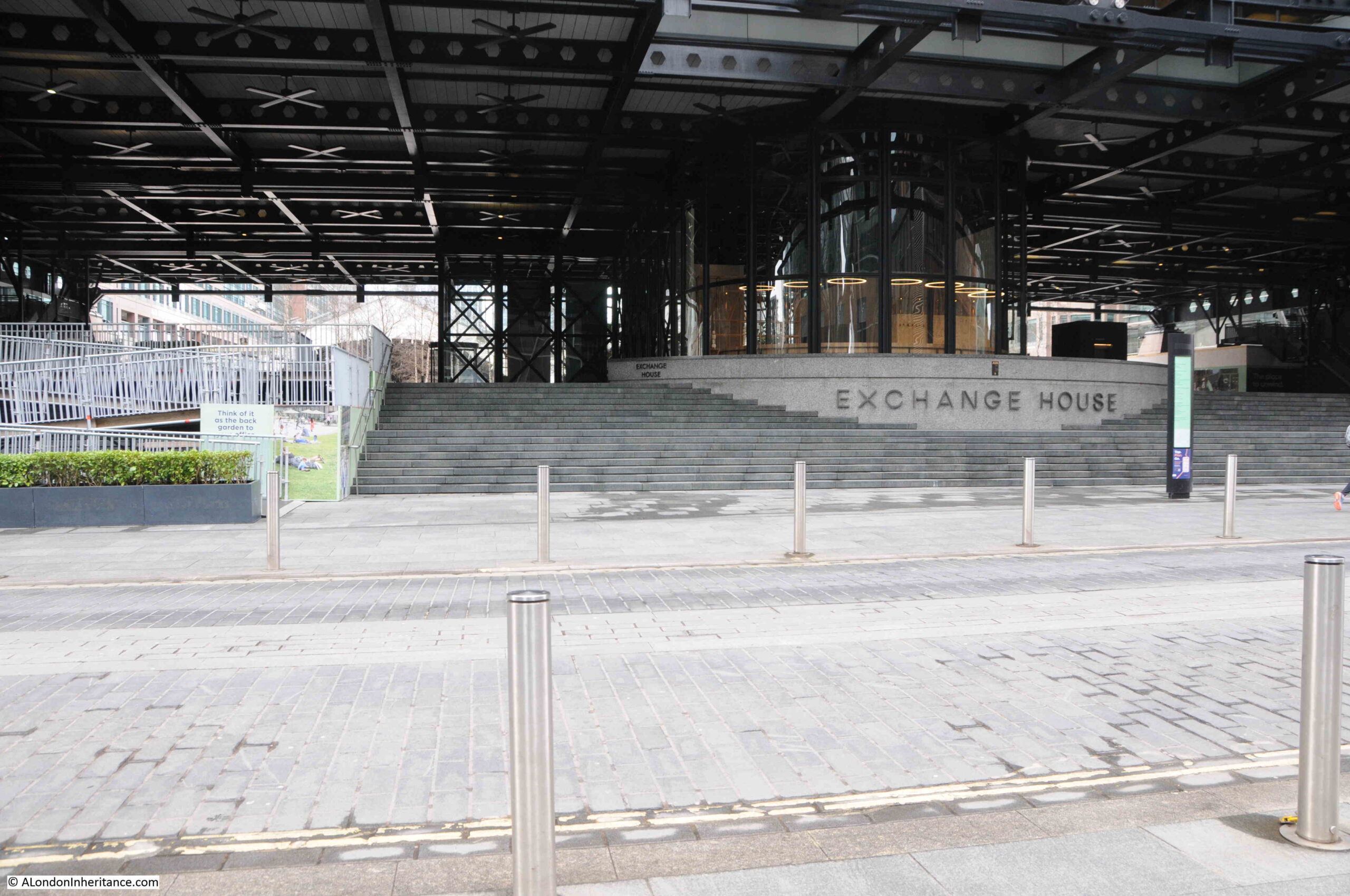
The bridge carrying Pindar Street was lost during the redevelopment of the area. The following photo is from under Exchange House looking towards the station. Pindar Street ran from left to right between the trees and seats, and just in front of where I was standing.
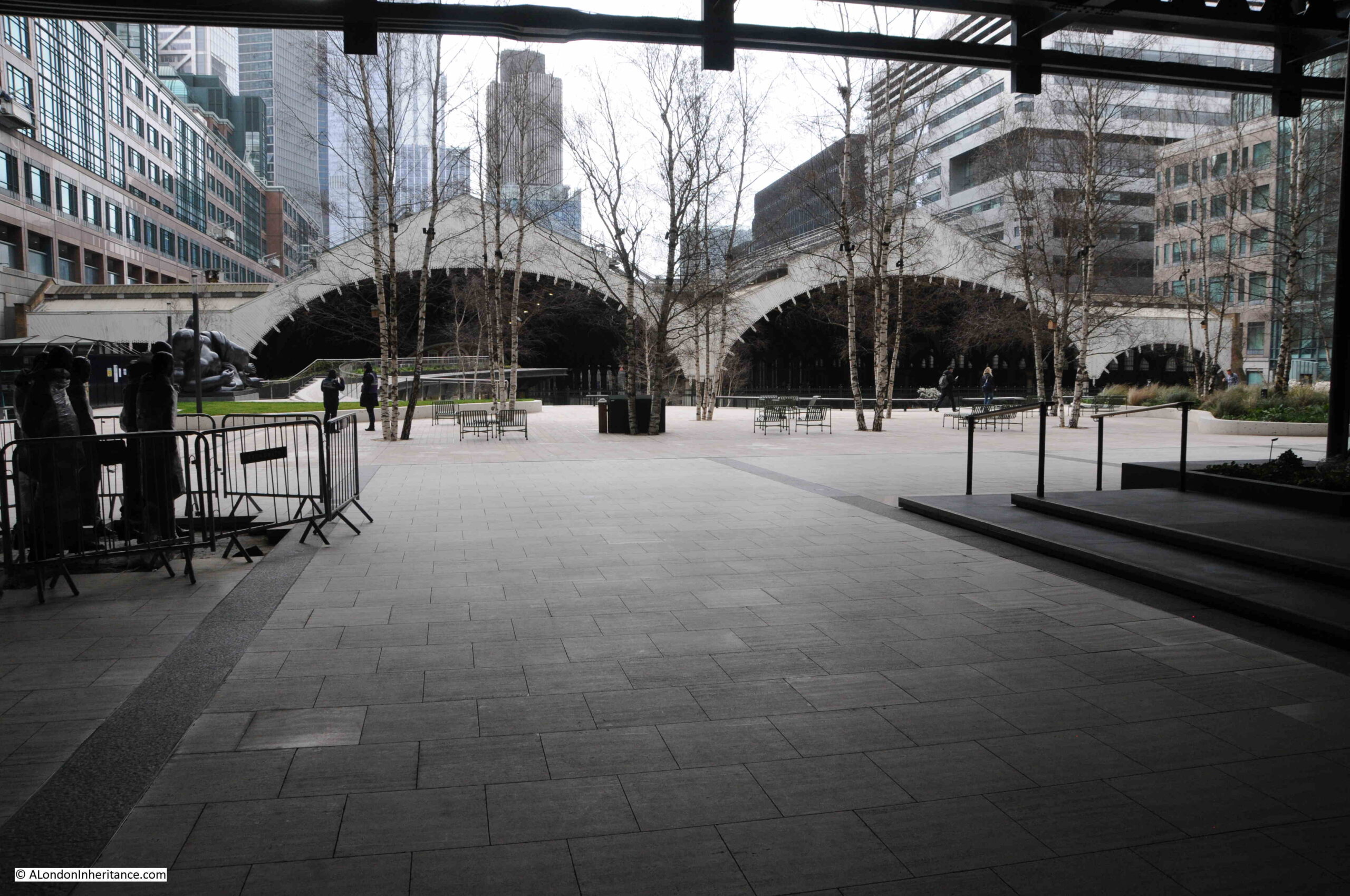
I suspect that my father was standing in the centre of the line of trees to take the photo at the top of the post, looking towards the right, to get the right-hand main arch of the roof, and part of the smaller arch on the right into the photo.
Exchange House is an interesting office block. Straddling the main rail tracks into Liverpool Street Station required some interesting construction techniques to be used. This is the building that can be seen from the Heron Tower with the metal arch crossing the façade of the building.
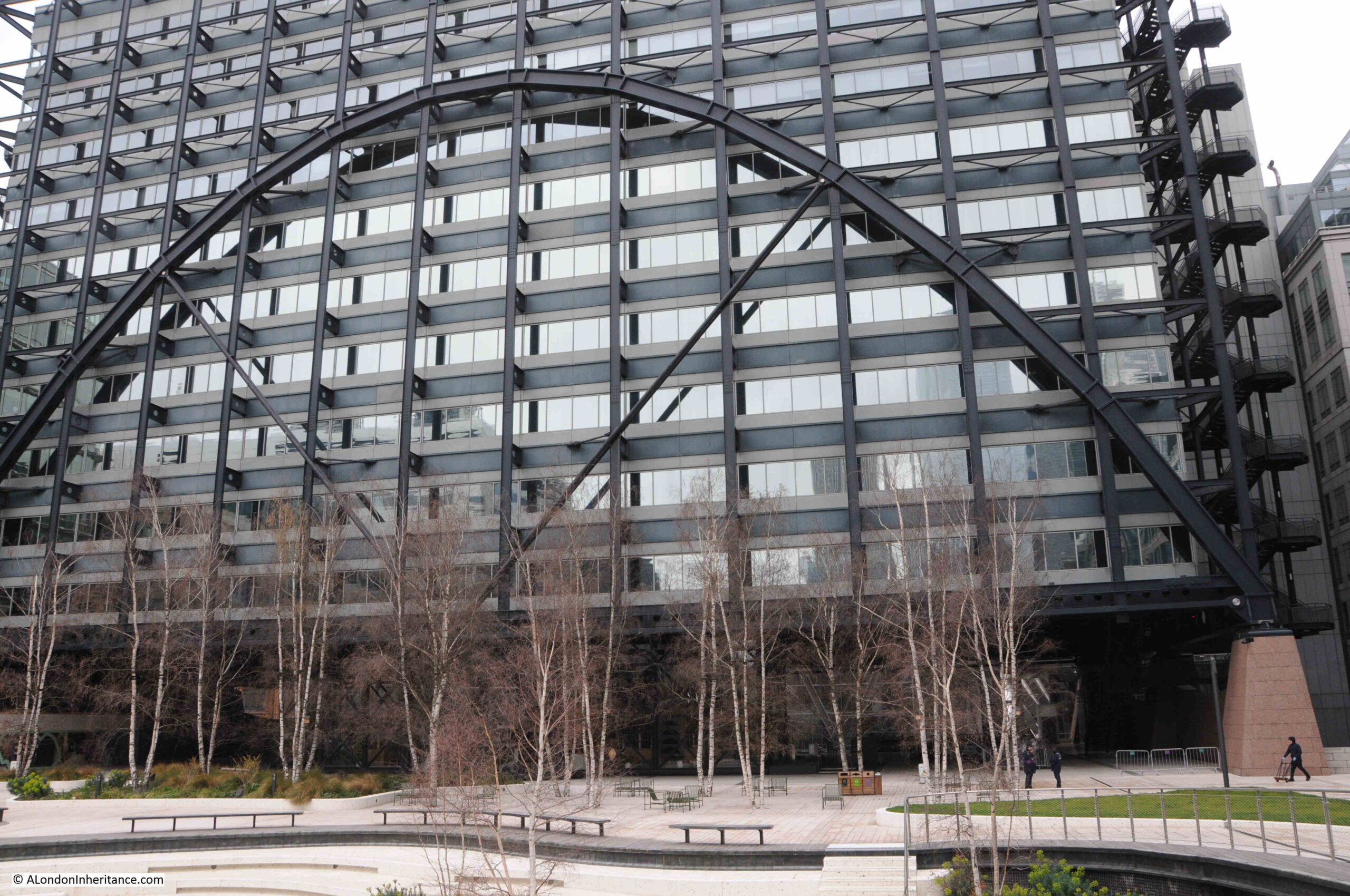
As the rail tracks are below Exchange House, it was not possible to put large amount of piling down to support the building, so much of the weight is supported on either side, where a supporting structure can be built down to ground level to the side of the rail tracks.
The metal arch is used to transfer some of this weight to the supporting structure, one side of which can be seen in the above photo to the right of the building.
View of the redeveloped Exchange Square:
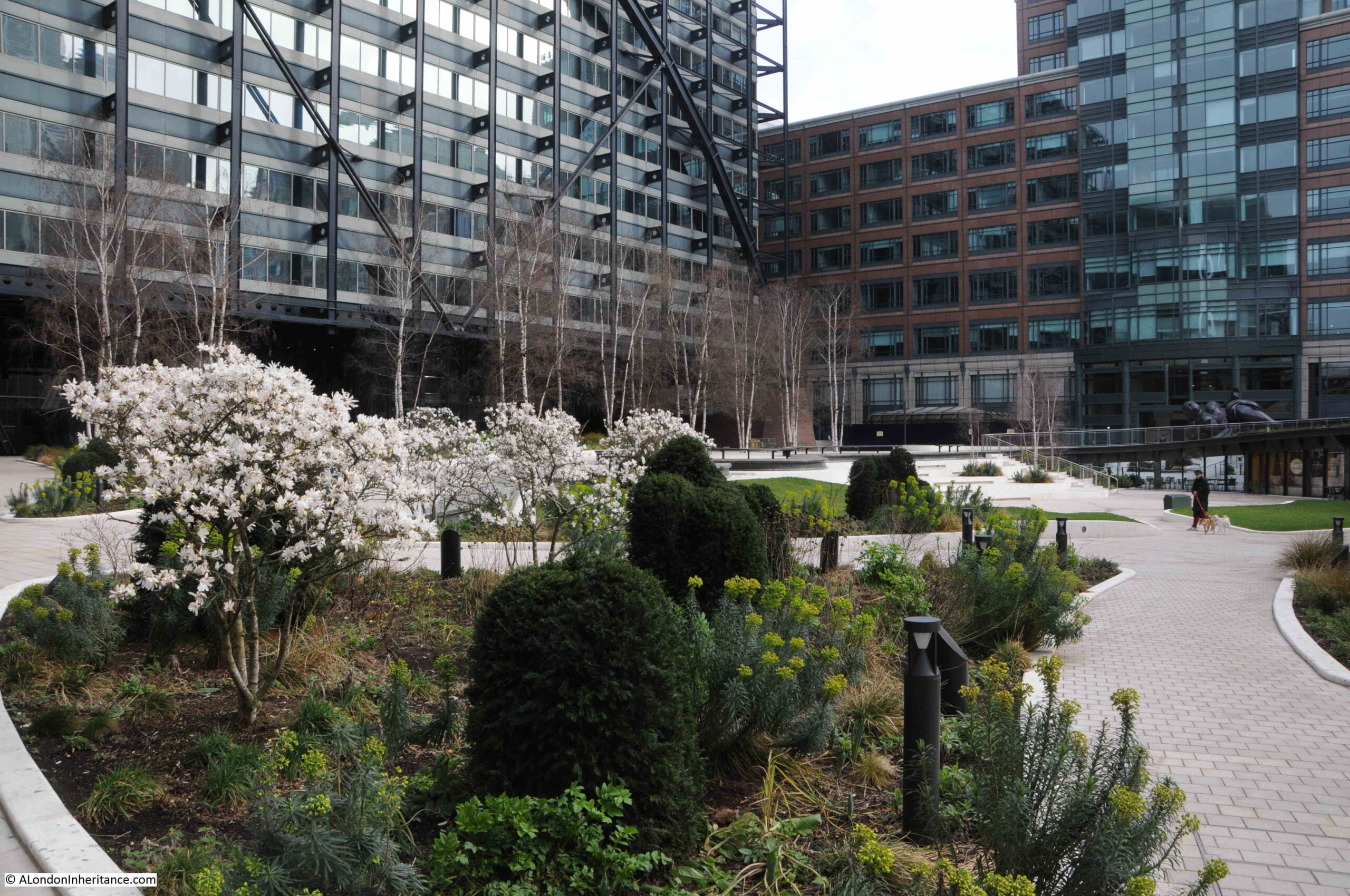
The architect for the redeveloped Exchange Square was the DSDHA architecture, urban design and research studio, and the project has been shortlisted for the RIBA London Award 2023.
I am not usually a fan of these small open spaces, which often come with a description by landowners and architects which far exceeds real experience of the space, however I really do like Exchange Square.
The space slopes towards the station, drawing the eye to the large sheds over the station platforms and tracks. There is a fair amount of planting, however a chilly and overcast Saturday in March was probably not the best time of year to view the planting and it will no doubt be better when established, and with better weather.
It was also really quiet when we were exploring the area. Only a dog walker and a security guard were walking through the square. Again, it is probably far busier in the week, rather than at the weekend.
Access to Exchange Square is not that obvious. There is access from Primrose Street (under Exchange House), and up some steps from Appold Street.
Access from Liverpool Street is along the side of the station. On the south eastern side, to the right of the escalators down to the concourse, there is a walkway which goes through the edge of the office blocks between the station and Bishopsgate.
From the south western side of the station, there is an open walkway which runs along the side of the station wall. This is the view along the walkway from Exchange Square.

The name of the walkway is Sun Street Passage. The name recalls one of the streets that was lost when Liverpool Street Station was built. There was a Sun Street, which I have highlighted in the following 1746 map, which ran across the station, under the current location of the platforms.
We walked along Sun Street Passage, with the high brick walls of the station on the left, and half way down there is an entrance into the station:

The above view is looking towards Exchange Square, which you can just see running across and above the platforms.
The concourse, where the roof runs at a ninety degree angle to the roof over the platforms, and with cleaned glass that allows a large amount of natural light to the area below:
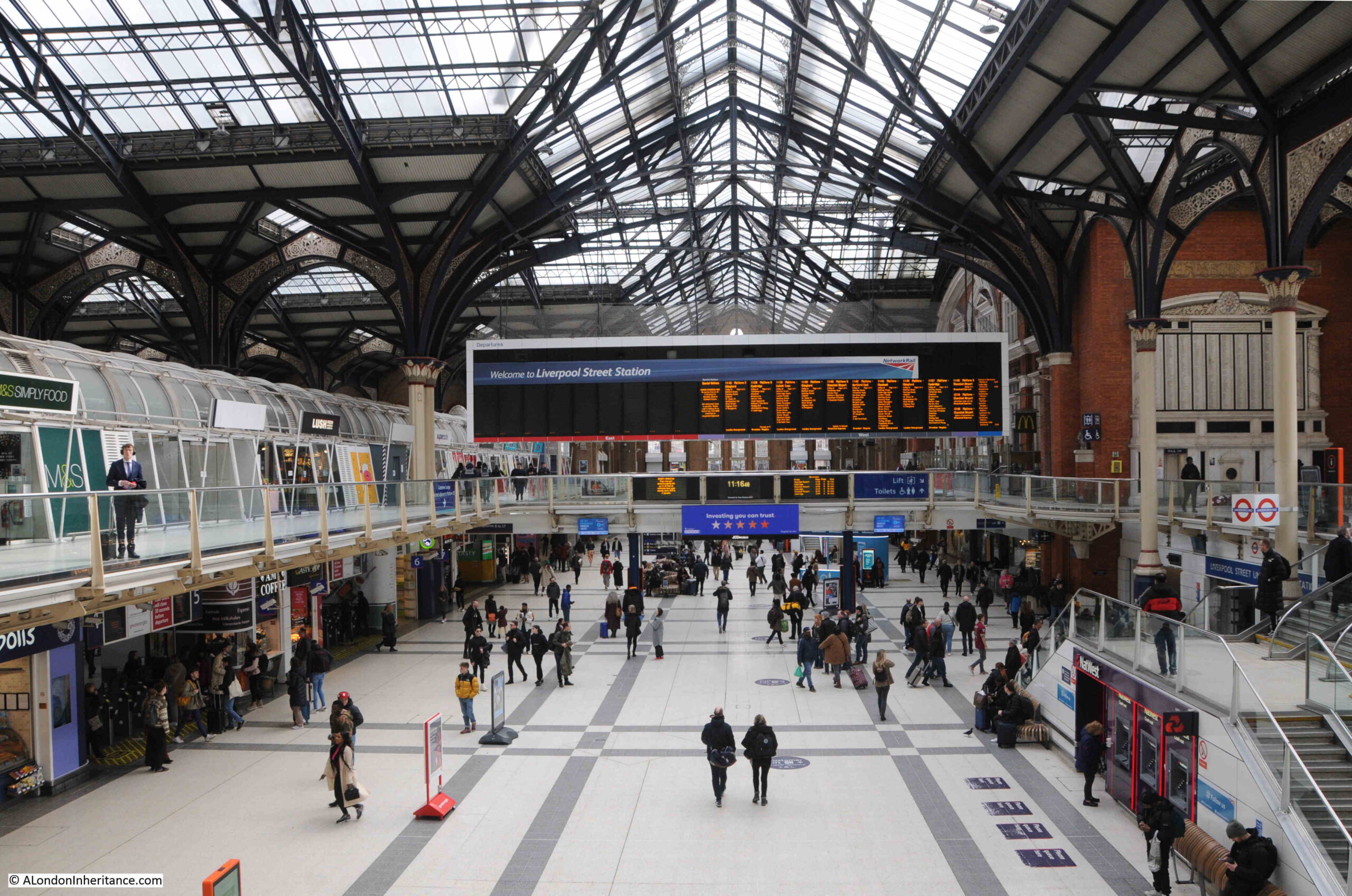
The station is so very different to when I used it every day during the 1980s. Much cleaner, the old destination indicators above the entrance to the platforms, where tickets where inspected manually, and always busy in the morning and evening commute, less so late in the evening when the pubs closed.
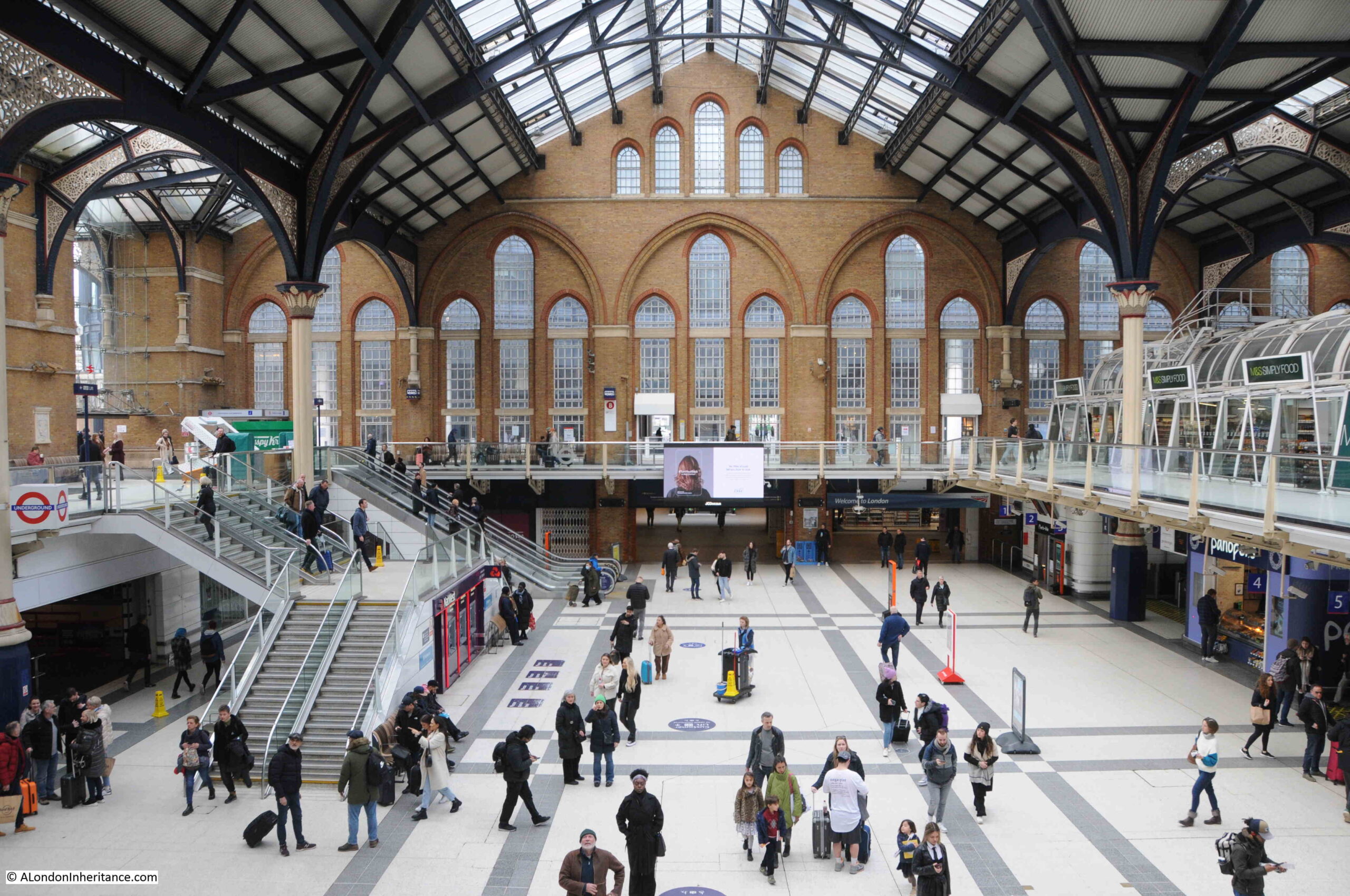
The above photo is from a walkway that crosses the centre of the station. This is looking towards where there was a cut through to Broad Street Station. On the left are the stairs running up to the exit to Liverpool Street (the street after which the station is named).
The following photo is looking in the opposite direction. At the far end there are stairs and escalator up to Bishopsgate. Both views again show that the concourse and platforms are below ground level.
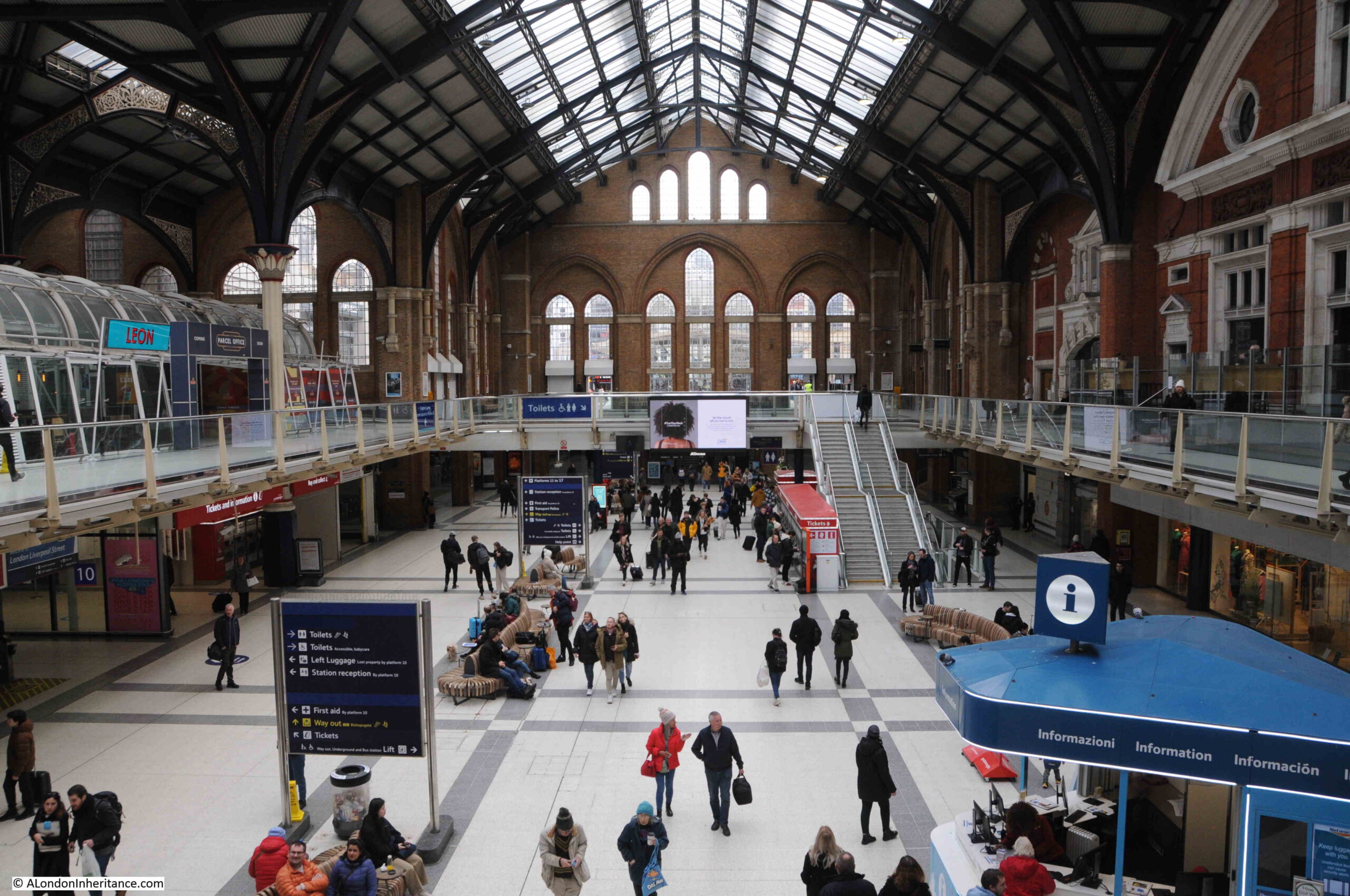
In the entrance space from Liverpool Street is the bronze sculpture “Kindertransport – The Arrival”, by Frank Meisler, which was installed in 2006:
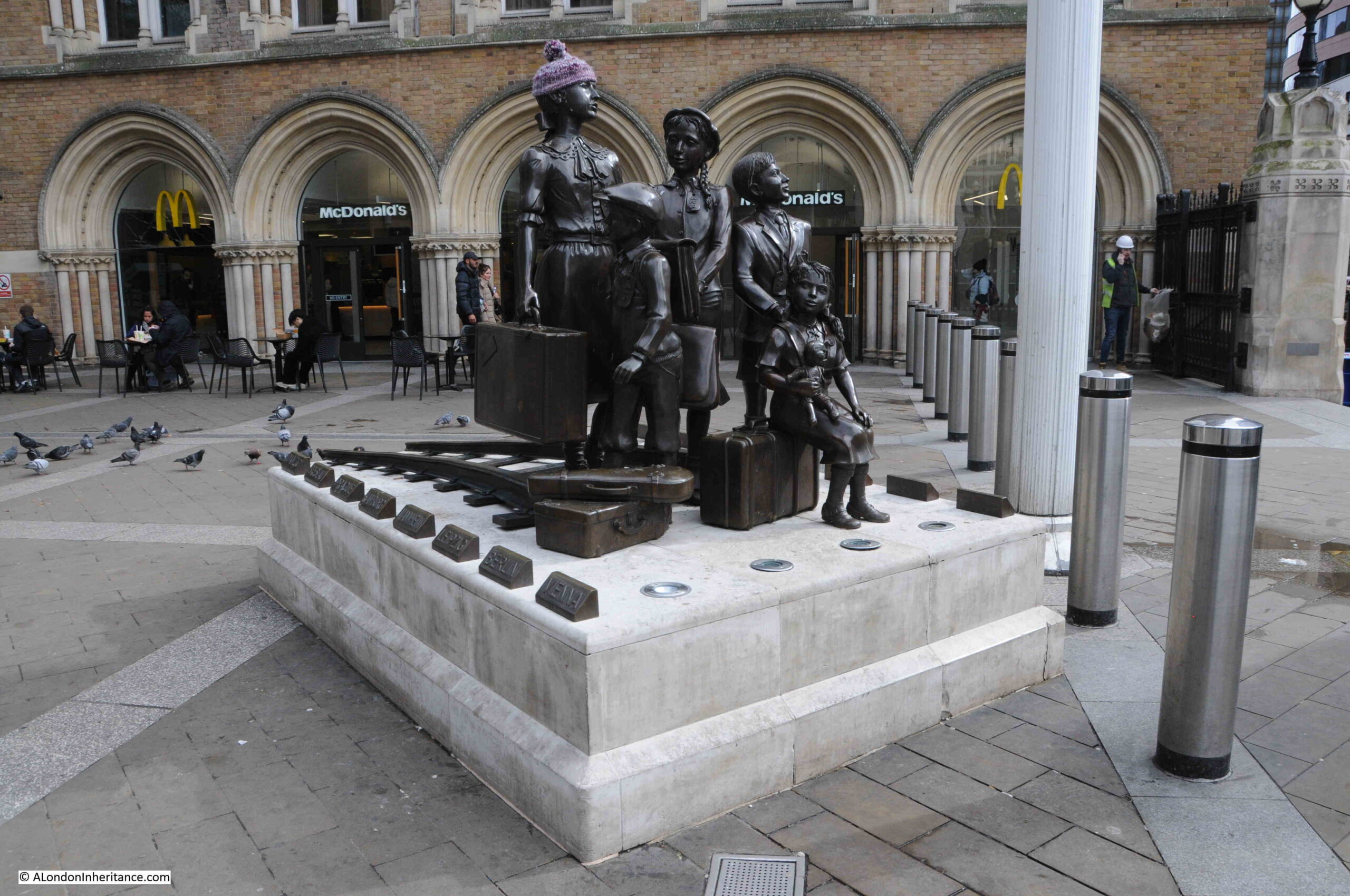
The memorial is to the almost 10,000 children who escaped Germany between 1938 and 1939, travelling by boat from the Hook of Holland in the Netherlands to Harwich, then by train from Harwich to Liverpool Street.
The following view is looking along Liverpool Street with the station buildings on the left:
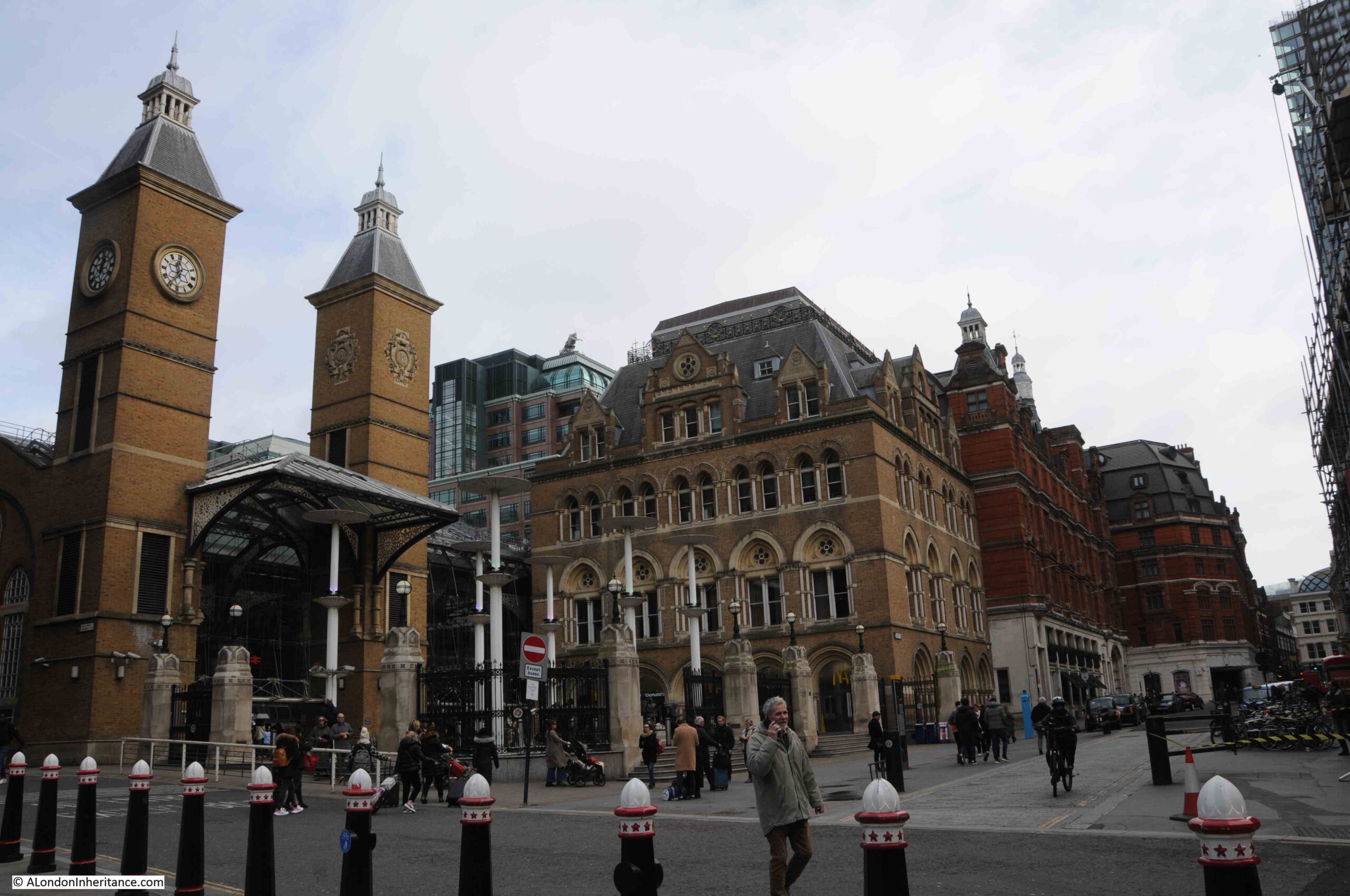
The two towers to the left of the photo were part of the late 1980s redevelopment of the station. The area occupied by the towers was a ramp providing access down to the area between Liverpool and Broad Street stations.
There are currently proposals for a major redevelopment of the station, which will see the towers and the lighter brick building demolished, and two large towers built over the space and above the original station buildings and station hotel which is the of the darker red brick.
The proposals would completely overwhelm the original station buildings, and those supporting the development claim that it would encourage people to travel back to the City and would improve the experience of the station users.
I think that what users of the station would really prefer is a cost effective, efficient train service, rather than the redevelopment, with two large glass and steel towers built over the station buildings.
The Victorian Society have launched a campaign to save the station, with the rather brilliant slogan (if you have used London’s transport system) of “See It, Say It, Save It”
The Architects Journal have an overview of the proposals, here, and the Victorian Society campaign introduction is here.
View along the side of the station. Exchange Square is at the far end:

On the railings around the station entrance are the arms of the Great Eastern Railway, the original company that operated into Liverpool Street Station, with the individual arms of places served by the railway, including Essex, Norwich, Ipswich and Cambridge:
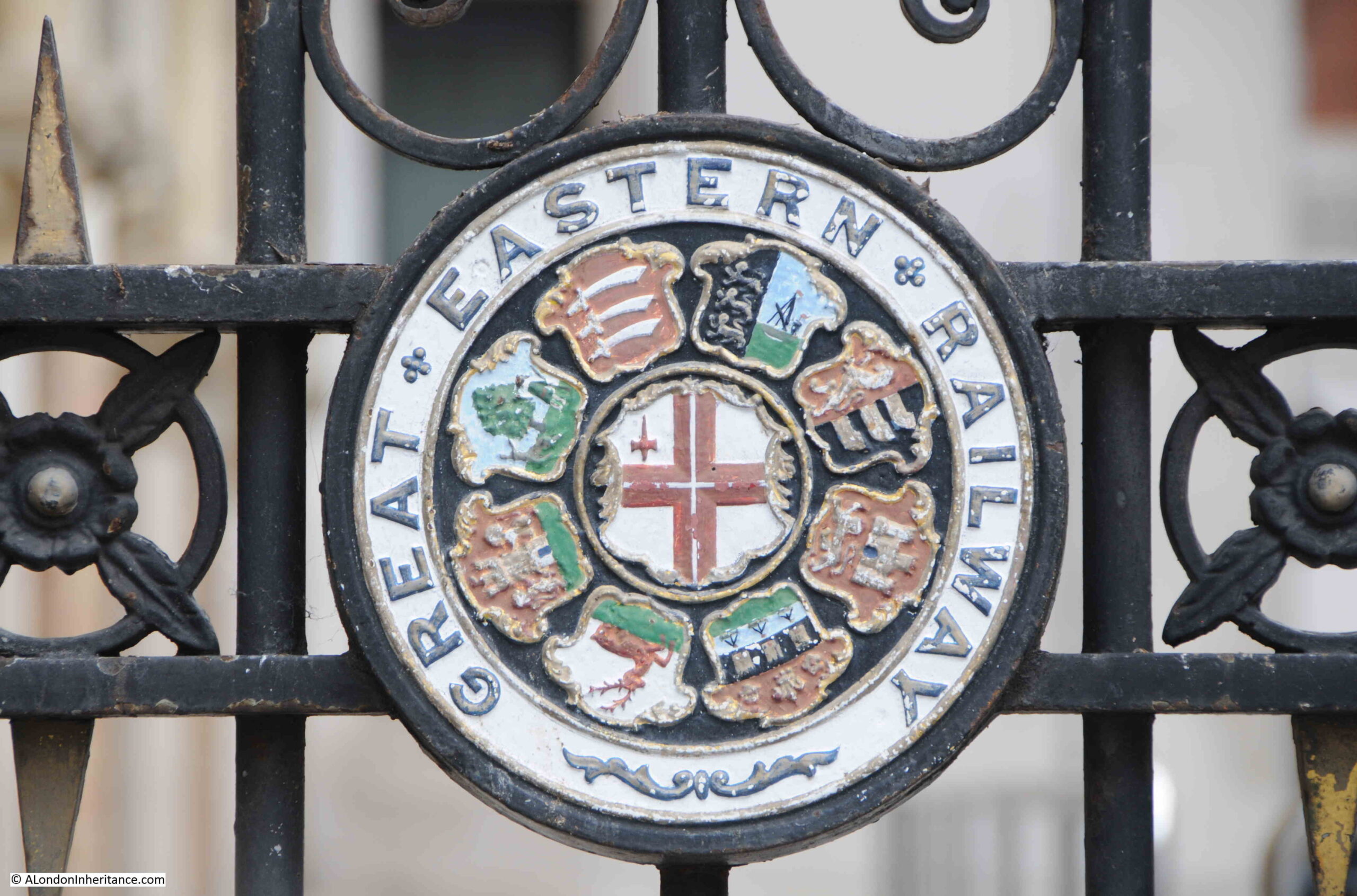
The station buildings on the corner of Liverpool Street and Bishopsgate:
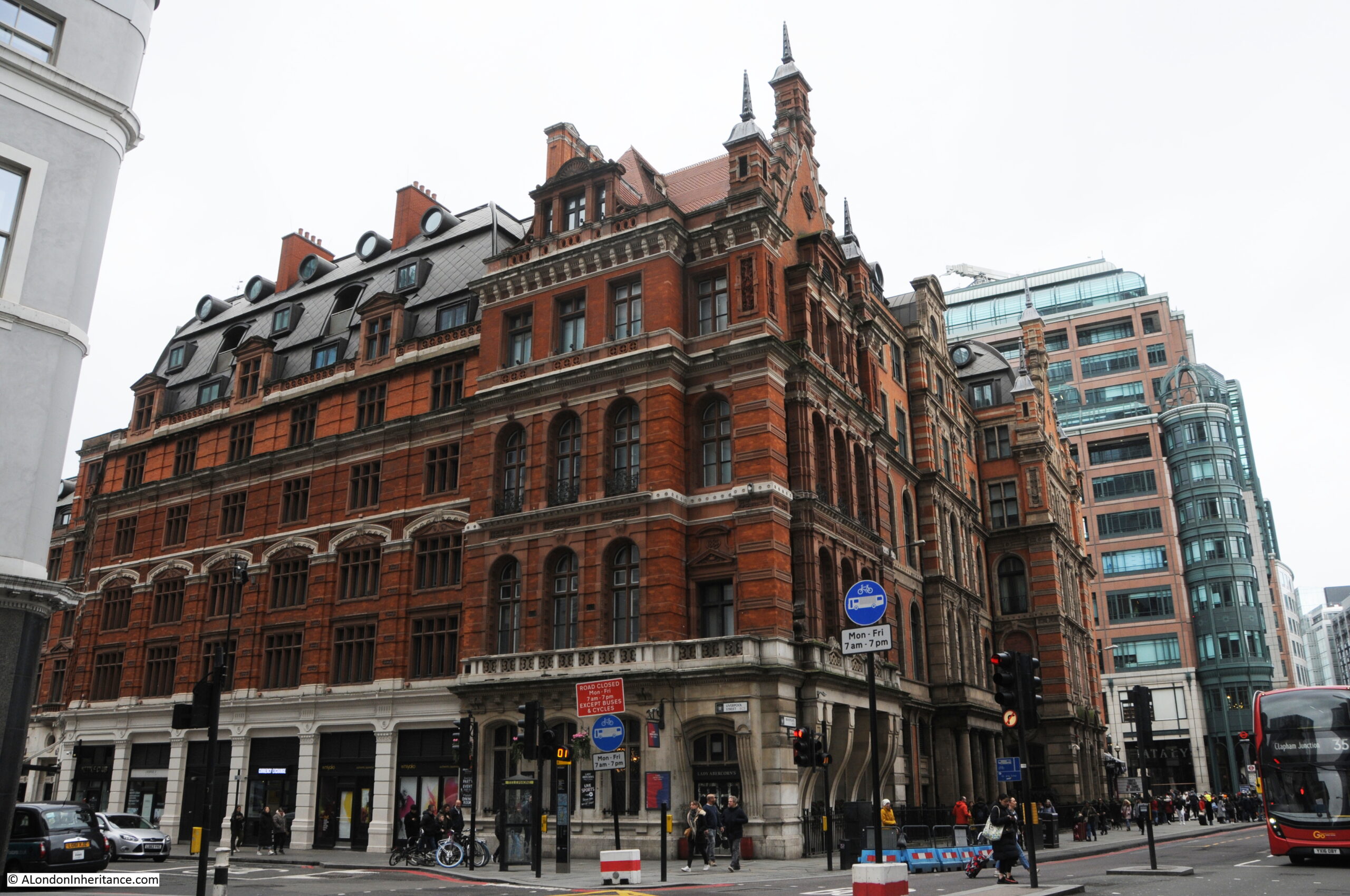
Liverpool Street Station, the development of the railway into Liverpool Street and the area in general has a fascinating history, which I shall return to, as the demands of a weekly post, as well as trying to limit my posts to 3000 words prevent inclusion in this post.
I have been waiting for the redevelopment of Exchange Square to complete, and I am really pleased that it is still possible to almost see the same scene as my father.
The details within the overall photo are also fascinating, and I shall leave you this week with the extract from the photo at the top of the post, showing a worker walking up to an engine. I do not know if he was the driver, but an everyday station scene from 71 years ago.

I just wish that I had taken some photos in all the years that I used Liverpool Street Station.


